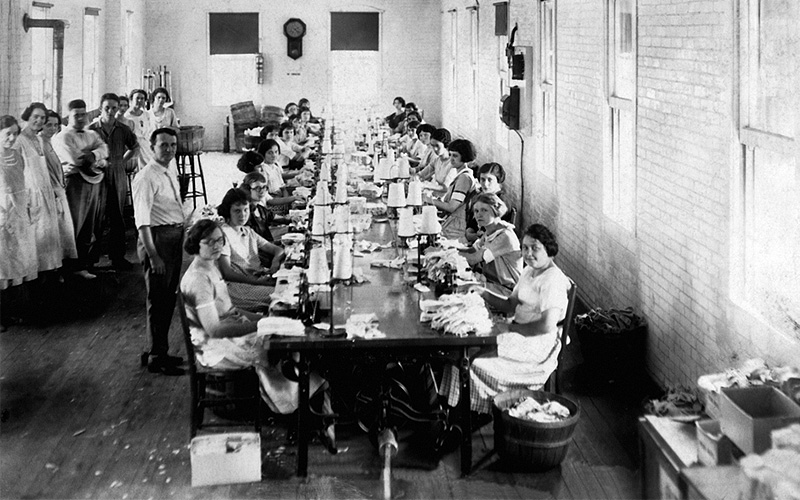
by guest blogger Renee James, humorist and blogger
When Maria told me the theme for this week was “slow fashion,” my first thought was, “What in the world is slow fashion?” Other than describing my usual default position of being very, very far behind on fashion trends, I had no clue. And then I thought, “Who could write a whole week’s worth of blogs about my missing fashion sense?” (Don’t answer that.)
Turns out “slow fashion” highlights and celebrates responsible use of environmental resources, as well as responsible sourcing of fabrics and other materials, along with the craftsmanship that goes into creating our clothing. So what in the world can I write about that? I’m no expert on running a competitive business or managing a skilled workforce. I don’t know anything about the garment industry or sewing. That’s all true: I don’t. But as it turns out, I grew up with people who did.
My uncle—and his father before him—owned and ran what used to be called a “blouse mill,” where dozens of women and some men sewed and shipped out thousands and thousands of blouses to wholesalers and retail customers in New York City. The seamstresses were members of the International Ladies’ Garment Workers’ Union, and as such, they enjoyed the benefits of a fair wage, reliable and consistent workdays, and the support of a union that would monitor their safety and work environment. They were proud of their skills and proud of the garments they produced. Over many decades in “the mill,” working with countless bolts of “goods,” generations of women from their small community considered my uncle—and each other—family.
My Grandmother Antoinette was also a seamstress, but in addition to creating garments, she helped create a modern workplace. She was a forewoman and an early union delegate at a factory called Strongwear Pants. In the 1920s, ’30s, and ’40s, she was a “working woman,” and shared a home with her husband, her brother-in-law and sister-in-law, and all their children. My grandmother and the men went to their jobs each day; my Great-Aunt Mary stayed home with the kids. As the other adults earned wages, Mary raised the children and managed the household, no doubt spending part of each day creating a “slow food” meal, but that’s another column. (Or is it?)
The large parcel of land they owned not only offered them the grand old home they built and shared, along with a huge barn/garage, but it also included some chickens, at least one donkey (I remember the pen from when I was a little girl), and a few goats. My grandfather always grew grapes, and back then, everyone made their own wine. This continued into my lifetime. The Sunday dinner table always had green glass soda bottles repurposed into carafes filled with homemade red wine. Their garden thrived, and “local” cuisine found its way into their kitchen by way of their own backyard.
I think it’s fair to say that about 100 years ago, any number of things could be called “slow” in a way we try to emulate today. Everything from the clothing our ancestors wore to the meals they served was “slow,” and they wouldn’t understand why that was so special or desirable. It was normal life. Outsourcing manufacturing of all kinds to factories and workforces overseas, away from U.S. union employees, was decades away. Replacing “scratch” cooking with slightly more convenient bottled, canned, and packaged ingredients was something Antoinette and Mary would not find useful or, more important, tastier.
Almost all the sewing mills I remember from childhood have shut down. Sadly, the land my ancestors owned has been parceled out for new homes, and only a small piece of their original property remains intact. The donkey pen is long gone, and the gardens have been replaced with driveways. Not all of that is a terrible thing, but at least some of it is, right?
I love modern conveniences, but I’m positive that when we embraced a number of them, we lost something tangible and something intangible along the way. We lost the spirit of community. We lost the connections that bound us to each other. We’ve somehow lost the proud concept of “a good day’s wages for a job well done.” We’ve instead contorted that into a rallying cry for “a good day’s wages…for pretty much anything.” Over the years, as demand went up and quality suffered, we learned to accept that and became comfortable with lower price tags and the idea of “replaceable” commodities. And in this land of plenty for not much money, we’ve largely ignored the fallout, both domestically, with jobs and entire industries now long gone, and overseas, where workforces are exploited for the sake of profits.
So the questions are these: If we can make one change, do one thing that can bring back even a shred of that feeling of fairness and equity and respect and treating each other (and the planet) well—not to mention supporting a skilled and valuable workforce—isn’t it worth doing? Part two: Isn’t it worth doing even if it costs us a little more?
Yes. Because in the end, I’m not sure any of us has the final tally on what “fast” everything really costs us.
 Renee A. James works at Rodale Inc. and wrote an award-winning op-ed column for The Morning Call, the Allentown, Pennsylvania, newspaper, for almost 10 years. Her essays were included in the humor anthology, 101 Damnations: A Humorists’ Tour of Personal Hells (Thomas Dunne Books, 2002), and are also found online at Jewish World Review and The Daily Caller. She invites you to Like her Facebook page, where she celebrates—and broods about—life on a regular basis, mostly as a voice in the crowd that shouts, “Really? You’re kidding me, right?” (or wants to, anyway), and she welcomes your suggestions, comments, and feedback to the mix.
Renee A. James works at Rodale Inc. and wrote an award-winning op-ed column for The Morning Call, the Allentown, Pennsylvania, newspaper, for almost 10 years. Her essays were included in the humor anthology, 101 Damnations: A Humorists’ Tour of Personal Hells (Thomas Dunne Books, 2002), and are also found online at Jewish World Review and The Daily Caller. She invites you to Like her Facebook page, where she celebrates—and broods about—life on a regular basis, mostly as a voice in the crowd that shouts, “Really? You’re kidding me, right?” (or wants to, anyway), and she welcomes your suggestions, comments, and feedback to the mix.




Yes, it is sad in many ways. Things you described here, as I was reading, took me back. I miss those days when real food was cooked by grandmothers and great-aunts in kitchens while they used lovely old tea towels and aprons. Those towels are only found in antique shops that sell textiles (table cloths, serviettes to match, lace doilies, embroidered pillow cases, etc.) and they can be expensive, but are usually affordable.
When I lived in Florida, I would frequent these shops because I loved the way the old textiles looked. The workmanship was exquisite in many cases, even with small stains. I purchased a few, and use them on my table for special occasions. I’m thinking of framing the lace doilies and hankies to showcase the beauty and time that it took someone to sit down and actually make something with their hands.
We have lost plenty with the “fast food” and “fast fashion” nation we’ve become. I don’t think that we can get the “slow” back because companies are so geared towards the bottom line. It seems that this is all that really matters now, when you get down to it. One may find pockets of “slow” in communities all across the country, but people want things convenient, and that means “fast.” Time is money, as they say, slow is “no go,” and fast is not the past. So it goes.
Thank you for your thoughtful comments, Donna. I think we can regain some of the “slow” pace we seem to miss and desire, by making some choices differently and making a financial impact on companies that are choosing quick money over slow money. But you’re right. It may not be as ubiquitous as it once was. We may have lost that forever.
My grandmother was a seamstress. She worked in a “factory” owned by an Italian immigrant. Most of the ladies who worked at the factory were from the old country. I used to visit and just loved it. The women were gossipy, happy, chatty, and I loved the size of the room, the wooden floors, the sewing tables, and most of all – the finishing table. Piles of blouses and skirts and the women sitting there all day sewing buttons, hooks and eyes, a little hem here, a small embroidery. I still have the huge spools of thread in so many colors. Of course I only use them for sewing on a button or fixing a hole – but I have every color a person could ever need. And talk about quality thread – it must be 60 years old and is still strong enough to break a tooth.
Thanks Val. When I was young, I thought everyone had a sewing machine (or two or three) in their house. The kind with the pedal you moved with your feet to make it run. And I remember those spools of thread!
And fabric. I can’t tell you how many bolts of fabric we found in my uncle’s attic when we were cleaning out the house. And the muslin! Countless yards of it. Unbelievable.
P.S. Turns out, it didn’t go to waste after all these years. I found an antiques dealer who sells old fabric to wardrobe departments in L. A. for 30s, 40s, 50s period film costumes. Who knew?